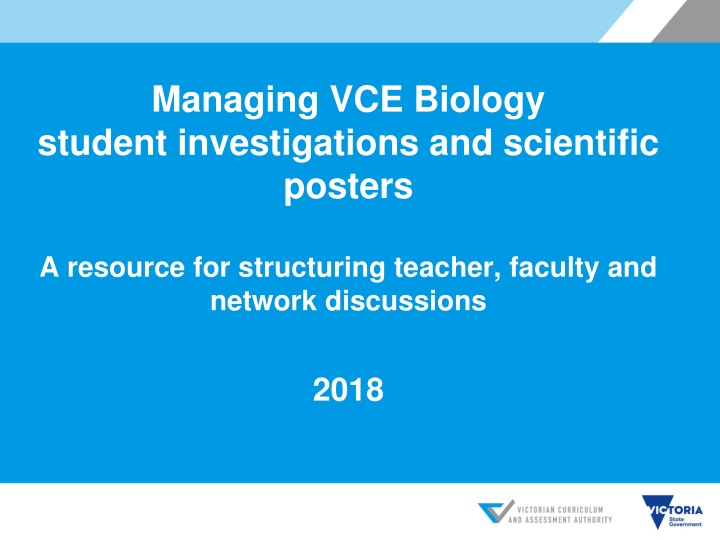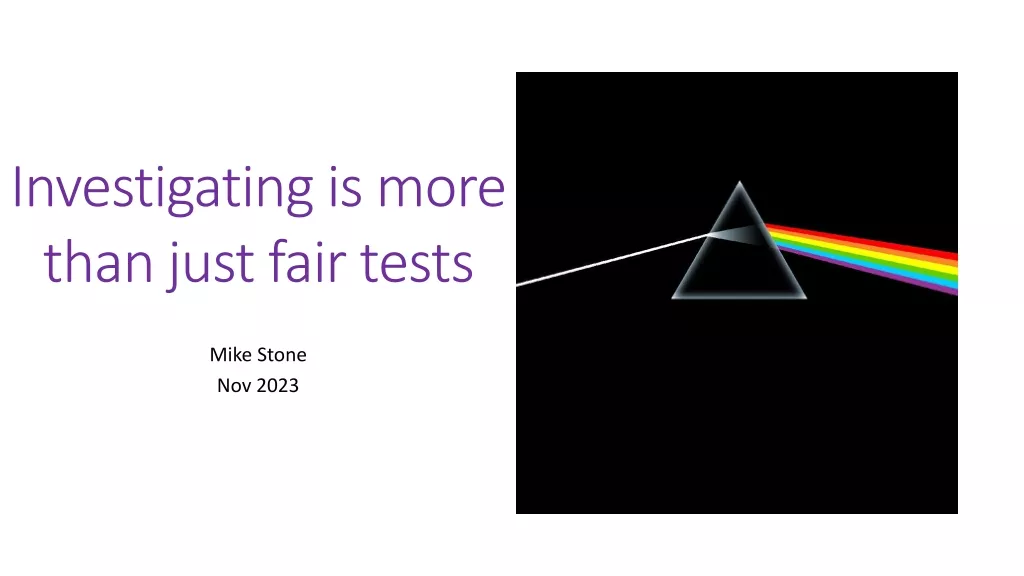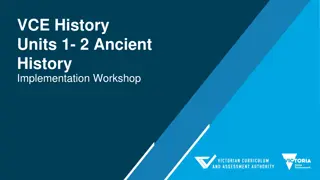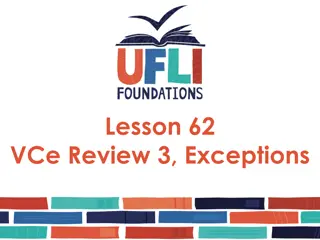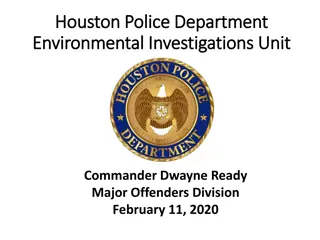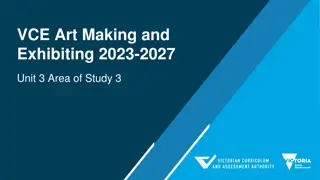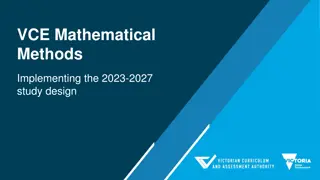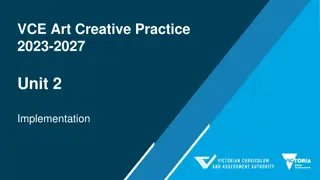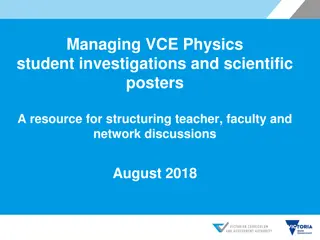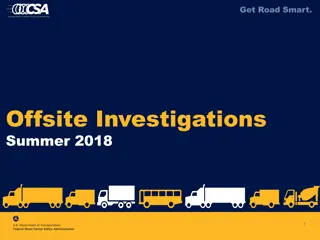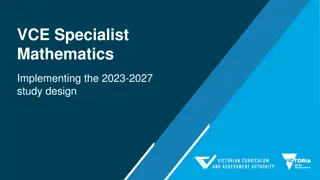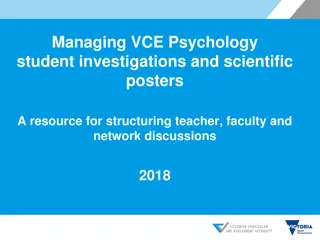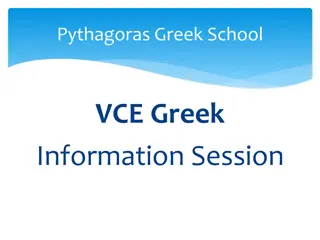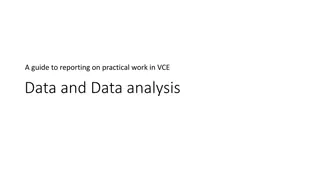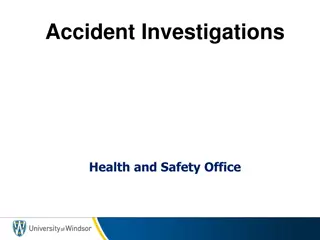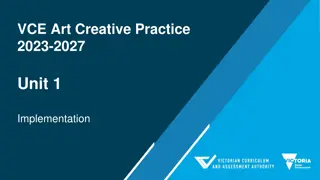Enhancing VCE Biology Student Investigations Through Structured Posters
Explore a comprehensive resource outlining the management of VCE Biology student investigations and scientific posters, covering topics from scientific poster requirements to evaluating student work for effective science communication strategies.
Download Presentation

Please find below an Image/Link to download the presentation.
The content on the website is provided AS IS for your information and personal use only. It may not be sold, licensed, or shared on other websites without obtaining consent from the author.If you encounter any issues during the download, it is possible that the publisher has removed the file from their server.
You are allowed to download the files provided on this website for personal or commercial use, subject to the condition that they are used lawfully. All files are the property of their respective owners.
The content on the website is provided AS IS for your information and personal use only. It may not be sold, licensed, or shared on other websites without obtaining consent from the author.
E N D
Presentation Transcript
Managing VCE Biology student investigations and scientific posters A resource for structuring teacher, faculty and network discussions 2018
Resource Outline Section A: Scientific posters Section B: Student investigation topics in Units 3 and 4 Section C: Approaches to running investigations Section D: Managing student-designed practical investigations across Units 3 and 4 Section E: Laboratory usage Section F: Putting it all together
Section A Scientific posters
Scientific poster Units 3 and 4 VCAA template For Units 3 and 4, students scientific posters must include the following seven sections: - Title - Introduction - Methodology - Results - Discussion - Conclusion - Acknowledgments and references Word limit is 1000 words Notes: The VCAA template referred to in the listed assessment tasks for Unit 4 Outcome 3 refers to seven sections listed on the left side of this slide Physical templates, including digital poster template layouts, are readily available, free of charge, on the Internet
Scientific poster Units 1 and 2 Unlike the scientific poster requirements for Units 3 and 4, teachers of Units 1 and 2 may choose to: change word limits (for example, decrease) provide greater scaffolding of the poster allow students to produce the poster as a group assignment/assessment task assess the poster as a group assignment/ assessment task. Discuss: How can poster sections be scaffolded such that there is a balance between providing support for students whilst enabling students to be differentiated, particularly at the top end ?
Evaluating scientific posters Prior to beginning work on constructing a scientific poster, it is useful to unpack the strengths and weaknesses of de-identified student work from previous years and/or scientific posters accessed on the Internet Display a selection of 10-20 posters around the classroom Students work in pairs or threes and use three different coloured post it notes representing strengths , limitations and suggestions for improvement to evaluate a poster Student groups then move around the room to evaluate remaining posters, overlapping similar comments provided by earlier groups Teacher leads a discussion to compare ideas and to summarise elements of effective science communication. Discuss: Is this activity worthwhile undertaking for Units 1 and 2 as well as for Units 3 and 4?
Scientific posters: Succinct communication of science Issues with student posters typically include: poster title not worded as a question including data tables (unnecessary) as well graphs inappropriate graph scaling, axes and labelling small font size not easily read too wordy lack of graphics/illustrations/flowcharts to balance words inclusion of unnecessary information. Further advice about the construction of scientific posters can be found in the Advice for teachers on the VCAA website
Discussion: Science communication The most common problem for students when constructing their scientific posters is exceeding the word limit and having a high word/graphic ratio. Discuss: What strategies can be used to assist students to communicate science ideas more succinctly? Which graphic types require explicit teaching as representations of science understanding and skills?
Poster logistics No drafts. In Units 1 and 2, a scientific poster may be based on research (library/secondary sources) or primary research. In Unit 3 or 4, or across Units 3 and 4, the poster: - must involve collection of primary data - must include seven sections of poster template, with acknowledgment of level of guidance - may be an extension of a common experiment or fieldwork exercise - may be generated by students based on their own research and subject to authentication (use of photos/video noted in logbook) - may be undertaken as a class with students contributing to design - may be assessed in stages (if modification required, original marks hold) - marks will be moderated against the examination class rank order important.
Poster authentication strategies Adopt and/or adapt current authentication strategies for tasks requiring extended experiments and/or practical activity reports Mark poster sections progressively Use specific questions about science investigation processes as part of the poster development under test conditions Logbook with dated entries should correlate to student work on poster Observed practical procedures in class Question students about content in specific parts of their poster. Discuss: Are other authentication strategies appropriate for your school? Do you have a school/faculty policy for authentication of student work?
Level of scaffolding for students Discuss: Refer to the next two slides to determine to what extent, and under what circumstances (if any), scaffolding should be provided for students designing, undertaking and reporting on their own investigations.
Teacher implementation example 1: Investigation planning scaffolding the investigation question Record the specific information that you will research during the research phase of your experiment into your logbook. Independent variable: An independent variable is the variable for which quantities are manipulated (selected or changed) by the experimenter, and assumed to have a direct effect on the dependent variable. Independent variables are plotted on the horizontal axis of graphs. Independent variable: A dependent variable is the variable the experimenter measures, after selecting the independent variable that is assumed to affect the dependent variable. Dependent variables are plotted on the vertical axis of graphs. Dependent variable: Question: Explain how the independent variable you have chosen will affect the dependent variable using theory:
Teacher implementation example 2: Structuring and assessing student poster discussion section scaffolding student work Respond to the following discussion questions on your poster: 1. Discuss whether the data you obtained supports your hypothesis, giving evidence. (2 marks) 2. Compare expected results with those of your experiment. Discuss any limitations or sources of error in the experimental design. Explain possible sources for outliers in the results if any were present. (2 marks) 3. Relate the findings of your experiment with the work of Billing and Sherman (1998). (2 marks) 4. Discuss how the results of your experiment might be used to reduce cases of food-borne illness. (2 marks) 5. Discuss the cellular processes that are impacted by observations made in your experiment. (2 marks)
Section B Student investigation topics in Units 3 and 4
Unit 4 Area of Study 3: Student-designed investigation Coupled or open inquiry Commonly, this investigation would involve coupled or open inquiry Student skills in inquiry types should be scaffolded Refer to the Advice for teachers for more information about coupled and open inquiry Scientific inquiry methods A range of inquiry methods area appropriate for the student-designed investigation Refer to the Advice for teachers for more information about scientific inquiry methods Investigation approval Not all student-designed investigations can be allowed to proceed Investigations must be managed in terms of resources, safety and authenticity.
Some interesting 2017 student investigation topics Which fruits contain protein-digesting enzymes? Does grass display phototropism to artificial light? Does garlic have a greater antimicrobial effect on Staphylococcus epidermis than coriander? Do natural remedies have any antimicrobial effect on E.coli? Are natural antiseptics as effective as commercial antiseptics? Does the quantity of mint added to a red meat sample affect the amount S.epidermis present? Do different antibiotics differentially affect the growth of E. coli and S. albus? Does the amount of pepper added in recipes affect the activity of antimicrobial organisms? How does pH affect the rate of fermentation of yeast? How does the rate of photosynthesis vary during the day? How does water salinity affect the rate of photosynthesis in aquatic plants? Is it best to grow plants with natural light or artificial light during the Australian winter? How does temperature affect lactic acid production in milk?
Investigable? Student question: How does ginger inhibit the growth of Staphylococcus epidermis? Discuss: Why is this question not an appropriate experimental investigation topic? Is this what the student actually wanted to investigate i.e. How ? Suggest how the question may be modified to enable investigation appropriate for Unit 3/4.
Discussion: Investigation ethics and safety Students cannot proceed with an investigation unless it is safe and ethical to do so. Discuss the role of each of the following in ensuring that investigations proposed by students are safe, ethical and manageable: student science coordinator classroom teacher laboratory technician.
Section C Sample approaches to running investigations
Developing investigation skills Investigations may involve students: generating primary data (practical investigation) collecting secondary data working in groups working independently. Discuss: VCE Biology offers flexibility for schools to scaffold the development of students inquiry and investigation skills. Use a table, such as the one below, to map your school s scaffolding of these skills: Unit Generate primary data Collect Work in groups Work secondary data independently 1 2 3 4
Sample approaches to structuring Unit 2 student investigations Investigation topic may relate to organisms and/or ecosystems Teacher determines extent of student choice, depending on resources and class sizes Students may undertake and report on their investigations as individuals or in groups. Discuss: Solving contemporary science problems generally involves teamwork. How can teamwork in undertaking a group investigation be organised and assessed?
Units 3 and/or 4 Sample approach 1: Variations on an investigation by changing independent and dependent variables What is the effect of temperature on the rate of reaction of catalase/amylase/lactase? What is the effect of pH on the rate of reaction of catalase/amylase/lactase? What is the effect of substrate concentration on the rate of reaction of catalase/amylase/lactase? What is the effect of enzyme concentration on the rate of reaction of catalase/amylase/lactase?
Units 3 and/or 4 Sample approach 2: Variations on an investigation by using an issue to generate student questions and by changing the independent variable Biological issue: Students will be investigating whether or not "natural remedies" have any anti microbial effect on E. coli. Does (tea tree oil/ garlic oil/ fresh garlic/ horseradish extract/ natural honey) have any anti-microbial effect on E. coli?
Units 3 and/or 4 Sample approach 3: Linking background research to a subsequent investigation There are only 8 students in my cohort. Students work in pairs. Topic of Investigation: The use of antibiotics in society. The question for investigation: Do commonly available bulbs, rhizomes, spices and herbs contain antibacterial compounds? Questions about spices (clove/cinnamon/sweet cumin): 1. Name at least two common spices that have antimicrobial compounds. 2. What diseases or conditions can these spices cure? 3. List some products available from these spices as medicines from the pharmacies, supermarket or sold online. Students subsequently develop their own questions for investigation based on their background research and logbook documentation.
Units 3 and/or 4 Sample approach 4: Different questions but same investigation Student 1: How does ampicillin affect E. coli and the zone of inhibition? Student 2: How will the variance in ampicillin concentration inhibit the growth of E. coli? Student 3: At what concentration will the growth of E. coli be inhibited by ampicillin ? Student 4: How will the antibiotic ampicillin affect the growth of bacteria Escherichia coli (E. coli)? Student 5: How does ampicillin inhibit the growth of E. coli? Discuss: What advice would you give Student 5 about their proposed question?
Units 3 and/or 4 Sample approach 5: Risk management in student investigations when students need assistance in generating questions Each student will be given the opportunity to develop their own scientific question for investigation of a key knowledge area in Unit 3 In the event of a student being unable to develop their own question the following scientific questions will be available: 1) Effect of light on rate of photosynthesis. 2) Effect of temperate on the rate of photosynthesis. 3) Effect of temperature on enzyme activity. 4) Effect of substrate concentration on enzyme activity. 5) Effect of pH on enzyme activity.
Units 3 and/or 4 Sample approach 6: Flipped classroom Students: have open choice of topic undertake own research out of class submit research investigation proposal. Teachers: approve/provide feedback re appropriate modifications to methodology monitor undertaking of investigation assess student capacity to design further investigations following completion of investigation.
Discussion: Structuring Units 1 to 4 student investigations A number of approaches can be used to structure student investigations across Units 1 to 4, including the six approaches listed in the previous slides. Discuss: Identify the strengths and limitations of the six approaches listed in the previous slides Evaluate the approach currently used at your school for structuring investigations across Units 1 to 4.
Section D Managing the student- designed practical investigations across Units 3 and 4
Typical timeline (suggested 7 to 10 hours) Approximately 2 hours: Students research question, research possible methods, confirm investigation with teacher and provide methodology and equipment list needed for the task. 2-4 hours: Students reflect on feedback from teacher about their proposed investigation, consider whether their proposed method is feasible and can be replicated, and refine scientific procedure as required. Commence data generation. Students maintain logbook records. Teacher checks and signs off logbook entries. 3-4 hours: Continuation of data generation, data processing and data analysis. Students were given electronic poster template in the last double period of week 3 and completed their own scientific poster. Discuss: Does the student investigation necessarily need to be completed in a single block of time?
Discussion: Unpacking key science skills The time allocated to the student-designed practical investigation requires that teachers: explicitly teach required knowledge and skills unpack students misconceptions/ uncertainties/ errors etc. Discuss: 1. How is the student design process managed in your class/ at your school? 2. How are students range of skill competencies catered for?
Testing students capacity to design investigations Unit 4 Outcome 3 in the study design requires that students design and undertake a practical investigation Discuss: Given that this outcome may be completed at any point across Units 3 and/or 4, discuss the strengths and limitations of assessing (diagnostic, formative and/or summative) students capacity to design investigations: (a) before they undertake their own investigation (b) after they undertake their own investigation (c) both before and after they undertake their own investigation.
Content basis of the VCE Biology student practical investigation in 2017 (N = 125) Unit 3 only for all students Unit 4 only for all students A choice of Unit 3 or Unit 4 for all students A mixture of Unit 3 and Unit 4 for all students 0 10 20 30 40 50 60 % schools
When was the VCE Biology student practical investigation undertaken in 2017? (N = 125) During Unit 3 During Unit 4 After the completion of Unit 3 and before commencing Unit 4 Staged across Unit 3 and Unit 4 0 5 10 15 20 25 30 35 40 45 % schools
Tips for effective feedback (from 7 Key Characteristics Of Better Learning Feedback by Grant Wiggins, updated 2017 Helpful feedback is: Goal-referenced Transparent Actionable User-friendly Timely Ongoing Consistent.
Discussion: Feedback Providing students with meaningful feedback can greatly enhance learning and improve student achievement. - various educational research findings Discuss: How and when do you provide feedback to students about their progress in: (a) VCE Biology? (b) the design, undertaking and reporting of their Unit 4 Outcome 3 investigation?
Section E Laboratory usage
Laboratory facilities for VCE Biology in 2017 (N = 49) Laboratories available at school for biology practical activities School has a designated biology laboratory School has a wet/dry laboratory for biology classes Virtual laboratories are used for activities not possible/available at school External laboratories are accessed for undertaking biology practical activities Laboratories are well fitted out for biology practical activities Required resources readily available or easily accessed 0 20 40 60 80 100 120 % schools
Virtual laboratories The 2017 VCE Biology SAC audit showed that over 40% of schools used virtual laboratories as part of their teaching and learning program, and over 50% of schools utilised local universities/science institutions to support their school programs Discuss: (a) What opportunities exist for extending VCE Biology outside the classroom? (b) Which other schools and VCE Biology organisational and teacher networks could be accessed for resource sharing?
What % time was spent teaching VCE Biology in a laboratory in 2017? (N = 49) exactly 100% between 75% and 100% % teaching time in a lab exactly 75% between 50% and 75% exactly 50% between 25% and 50% exactly 25% between 0% and 25% exactly 0% 0 10 20 30 40 50 60 70 80 90 % schools Discuss: How is safety managed when performing investigations outside a laboratory?
How much notice was given to lab techs to prepare practical activities for biology in 2017? (N = 49) 1 day 2 days 3 days Between 3 days and 1 week Between 1 and 2 weeks 2 weeks Longer than 2 weeks 0 5 10 15 20 25 30 35 % schools
Science faculty experimental investigation planner Lab managers and science leaders should work together to plan investigations across all VCE sciences for a calendar year so that neither human nor physical resources are exhausted Units 1 and 2 can be taught in any order; Units 3 and 4 must be taught as a sequence.
Sample experimental investigation planner Jan Feb Mar Apr May Jun Jul Aug Sep Oct Nov Dec VCE Science Unit Biology 1 2 3&4 Chemistry 1 2 3&4 Enviro Science 1 2 3&4 thermo Physics 1 2 3&4 Psychology 1 2 3&4 No labs Experimental investigation Research investigation Physics options Colour coding
Section F Putting it all together: reflection
Managing change The same old thinking The same old results Reflection/discussion: What worked well last year? What did not work well last year? How is student topic selection managed? How is laboratory work managed across the science faculty? Is the poster assessed in stages? At what stages do students receive feedback? What could be improved this/next year?
